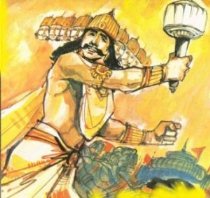History
The earliest references of Ayurveda medicine in Sri Lanka are associated with a great physician; Ravana a king of Sri Lanka dating back to the prehistoric times. Traditionally, it is believed that Ravana of Ramayana fame was well versed in Ayurveda medicine. Ramayana mentions that he represented Sri Lanka at a medical symposium at the base of Himalaya in India during his era. There were four tribes, Yaksha, Raksha, Naga and Vaddas in Sri Lanka at the given time. According to Historiography in Sri Lanka King Ravana was the author of the following medicine books of Ayurveda. Arkaprakasya, Nadivignanaya, Kumarathanthraya and Udishathanthraya.
 Sri Lanka has a rich assortment of medicinal plants of which some are endemic to the country. The majority of the plants used are the same as those used in India. Dolukanda and Rumassala are believed to be fragments of a part of Himalayas that were carried over to Sri Lanka by the mythical monkey King Hanuman of King Rama. Evidence unearthed from prehistoric burial sites speaks of the ancient practices of Ayurveda across Anuradhapura, Polonnaruwa, Madirigiriya and Pomparrippu.
Sri Lanka has a rich assortment of medicinal plants of which some are endemic to the country. The majority of the plants used are the same as those used in India. Dolukanda and Rumassala are believed to be fragments of a part of Himalayas that were carried over to Sri Lanka by the mythical monkey King Hanuman of King Rama. Evidence unearthed from prehistoric burial sites speaks of the ancient practices of Ayurveda across Anuradhapura, Polonnaruwa, Madirigiriya and Pomparrippu.
The only structural remains of ancient hospitals that have so far come to light are of those established in the old monasteries of Mihintale, Madirigiriya and Alahana in Polonnaruwa. The identity of those hospitals has been established with the help of inscriptions and discovery of medicine and other equipment. As a reference to the Mahavamsa and Chulavamsa many of the ancient kings have dedicated their services to the development of Ayurveda medicine in Sri Lanka. Examples of such practices are King Pandukabhaya (4th Century BC), King Sena (851-885 AD), King Buddhadasa (362-409 AD), King Datusena (460-478 AD) etc. As such ancient Ayurveda evidence show that Sri Lanka has inherited a glorious history of indigenous medicine in the country.
But it faced setbacks during the late part of the 16th century due to foreign invasions. Afterwards Ayurveda developed on an own on an independent process.It is practiced anualy as a traditional process. (Parental inheritance) Ex: Es Vedakama (Ophthalmology) Gedi Vana (Treatment of boils and carbuncle), Sarpavisha (Toxiology), Pissubalu (Hydrophobia), Vidum Pillissum (Burns), Kadum Bidum (Fractures and Dislocation).
At Present There are about 16,800 registered Ayurvedic medical officers of which more than 5000 are academically and institutionally qualified to serve the country and nation.